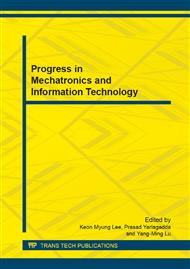[1]
Luo JZ, Wang XP, Song AB. A semantic access control model for grid sevices. In: Proc. of the 9th Int'l Conf. on Computer Supported Cooperative Work in Design. Coventry: IEEE Press, 2005. 350-355.
DOI: 10.1109/cscwd.2005.194196
Google Scholar
[2]
Ryutov T, Zhou L, Neuman C, Leithead T, Seamons K. Adaptive trust negotiation and access control. In: Proc. of the 10th Symp. on Access Control Models and Technologies (SACMAT 2005). New York: ACM Press, 2005. 139-146.
DOI: 10.1145/1063979.1064004
Google Scholar
[3]
J. Kelley, R. Campagna. Network Access Control For Dummies. Denzil Wessels, (2009).
Google Scholar
[4]
R. Yuan, W. T. Strayer. Virtual Private Networks: Technologies and Solutions (1st Edition). Addison-Wesley Professional, (2001).
Google Scholar
[5]
Jun Gao, Peter Steenkiste. An access control architecture for programmable routers. 2001 IEEE Open Architectures and Network Programming Proceedings, Alaska, pp.15-24, (2001).
DOI: 10.1109/opnarc.2001.916835
Google Scholar
[6]
Cisco Company. Cisco network admission control [EB/OL]. http: /www. cisco. com/en/US/ netsol/ns617/index. html.
Google Scholar
[7]
Trust Computing Group. TCG specification trusted network. Connect TNC architecture for interoperability revision 1. 1 [EB/OL]. http: /www. trustedcomputinggroup. org/, (2005).
Google Scholar
[8]
Liu Wei, Yang Lin, Dai Hao, etal, A new network acaccess control method and performance analysis of authentication session[J]. Chinese Journal of Computers, 2007, 30(10): 1805-1812.
Google Scholar
[9]
Zhang Li, Qi Jin, Lv Luning, etal, Research and design of network access control technology[J]. Information Security and Communications Privact, 2009, 31(9): 60-62.
Google Scholar
[10]
Yuan Hao. Inter access network security [M]. Beijing: Publishing House of Electronics Industry, 2011: 293-299.
Google Scholar
[11]
J. Kelley, R. Campagna. Network Access Control For Dummies. Denzil Wessels, (2009).
Google Scholar
[12]
S. McClure, J. Scambray, and G. Kurtz. HACKING EXPOSED 6 Edition Network Security Secrets & Solutions. McGraw-Hill Osborne Media, (2009).
Google Scholar
[13]
Ferraiolo D, Kuhn DR. Role-Based access control. In: Proc. of the 15th National Computer Security Conf. 1992. 554-563. http: /csrc. nist. gov/rbac/ferraiolo-kuhn-92. pdf.
DOI: 10.1145/270152.270165
Google Scholar
[14]
Sandhu R, Coyne EJ, Feinstein HL, Youman CE. Role-Based access control models. IEEE Computer, 1996, 29(2): 38-47.
DOI: 10.1109/2.485845
Google Scholar
[15]
Sandhu R, Bhamidipati V, Munawer Q. The ARBAC97 model for role-based administration of roles. ACM Trans. on Information and System Security (TISSEC), 1999, 2(1): 105-135.
DOI: 10.1145/300830.300839
Google Scholar
[16]
Ferraiolo DF, Sandhu R, Gavrila S. Proposed NIST standard for role-based access control. ACM Trans. on Information and Systems Security (TISSEC), 2001, 4(3): 224-274.
DOI: 10.1145/501978.501980
Google Scholar
[17]
Fenkam P, Dustdar S, Kirda E, Reif G, Gall H. Towards an access control system for mobile peer-to-peer collaborative environments. In: Proc. of the IEEE 11th Int'l Workshops on Enabling Technologies: Infrastructure for Collaborative Enterprises (WETICE 2002). IEEE Computer Society, 2002. 95-102.
DOI: 10.1109/enabl.2002.1029995
Google Scholar
[18]
Wang Y, Vassileva J. Trust and reputation model in peer-to-peer networks. In: Proc. of the 3rd Int'l Conf. on Peer-to-PeerComputing. IEEE Press, 2003. 150-157.
Google Scholar
[19]
Wang Y, Vassileva J. Bayesian network-based trust model. In: Proc. of the IEEE Int'l Conf. on Web Intelligence. IEEE Computer Society, 2003. 372-378.
Google Scholar
[20]
Cisco Network Admission Control Architecture[EB/OL]. http: /www. cisco. com/en/US/netsol/ ns466/networking_solutions_package. html.
Google Scholar


